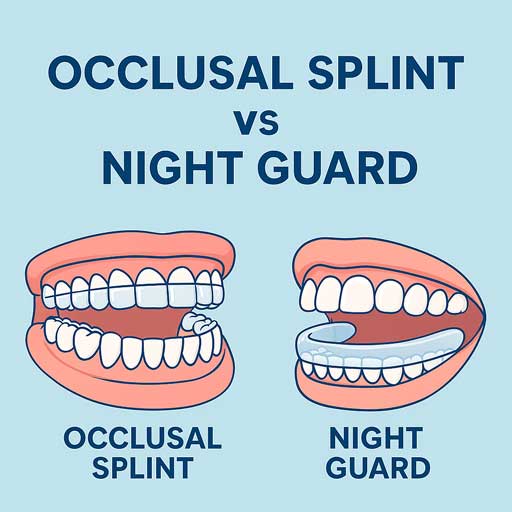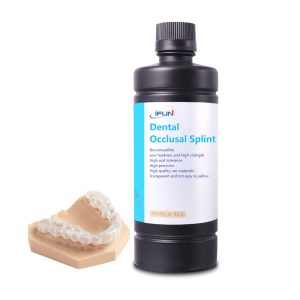Dental professionals are increasingly encountering patients presenting with bruxism, temporomandibular joint disorders (TMD), and related occlusal issues. One of the most common clinical questions is: “What’s the difference between an occlusal splint and a night guard?” Understanding the distinction between these two appliances is crucial not only for proper diagnosis and treatment planning but also for effective patient education.
This article breaks down the differences between occlusal splints and night guards, discusses their clinical applications, material types, and fabrication methods, and offers guidance on choosing the right solution for each patient, including a breakdown of occlusal splint cost considerations.

What Is an Occlusal Splint?
An occlusal splint, also referred to as a stabilization splint or bite splint, is a custom-made dental appliance designed to modify the occlusion and relieve pressure on the temporomandibular joints. It is typically fabricated from hard acrylic and fits over either the upper or lower dental arch.
Occlusal splints are indicated for:
- Temporomandibular joint disorders (TMD)
- Muscle hyperactivity and tension headaches
- Severe bruxism and clenching
- Occlusal instability
Unlike soft guards, occlusal splints are carefully calibrated to achieve proper occlusal contacts and may require adjustments over time. Their primary function is therapeutic.
What Is a Night Guard?
A night guard is a simpler protective appliance used primarily to prevent damage from nocturnal bruxism. Night guards act as a barrier between the upper and lower teeth, absorbing grinding forces and minimizing tooth wear.
Night guards can be:
- Over-the-counter (OTC): made from thermoplastic or silicone, one-size-fits-most
- Custom-fabricated: based on patient impressions or intraoral scans, offering a more precise fit
They are not designed to change occlusion or treat TMJ disorders but provide passive protection against tooth damage.
Occlusal Splint vs Night Guard: Key Differences
| Feature | Occlusal Splint | Night Guard |
| Purpose | Therapeutic (e.g., TMD treatment) | Protective (bruxism prevention) |
| Material | Hard acrylic resin | Soft or dual-laminate (EVA, silicone) |
| Customization | Highly individualized | Maybe custom or generic |
| Adjustability | Requires occlusal adjustments | No adjustment or limited |
| Clinical Use | Prescribed after diagnosis | Often patient-driven purchase |
The distinction is not just semantic. Misidentifying one as the other can result in suboptimal outcomes, especially in complex TMD cases.
Indications: When to Use Each
Occlusal Splint:
- Diagnosed TMD or myofascial pain
- Chronic jaw muscle fatigue
- Occlusal disharmony needing therapeutic positioning
Night Guard:
- Mild to moderate bruxism
- No clinical signs of TMJ dysfunction
- Cost-sensitive patients seeking temporary relief
A thorough patient assessment—including palpation, range-of-motion tests, and possibly joint imaging,is essential before prescribing an occlusal splint.
Materials and Fabrication Process
Occlusal Splints are usually fabricated from:
- Hard heat-cured acrylic resin (PMMA)
- CAD/CAM milled PMMA blocks
- 3D printed biocompatible resin (in modern practices)
Night Guards may use:
- Soft thermoplastic or dual-laminate materials
- Vacuum-formed or pressure-formed techniques
- Direct intraoral molding (for OTC variants)
Digital workflows (intraoral scanning + 3D printing or milling) significantly improve turnaround time and appliance precision for both types.
Occlusal Splint Cost Considerations
The cost of an occlusal splint is generally higher than that of a night guard due to its complexity and therapeutic nature. Key cost factors include:
- Custom fabrication: $300–$800+ depending on region and lab
- Clinical time: Requires multiple appointments for fitting and adjustments
- Material and technology: Milled or printed splints may cost more than traditionally processed ones
- Insurance: Some dental or medical insurance plans partially cover occlusal splints when used to treat TMD, unlike standard night guards
By contrast, night guards may range from $20–$50 for OTC versions, and $100–$300 for custom-made guards.
Clinical Tip: Choosing the Right Appliance
When deciding between an occlusal splint and a night guard, consider:
- Symptom complexity: Is it just bruxism or are there TMJ symptoms?
- Occlusal stability: Is occlusion contributing to the problem?
- Patient budget and expectations
- Need for long-term management
Ultimately, an occlusal splint is a medical appliance designed to treat underlying dysfunction, while a night guard is a preventive device. Matching the solution to the clinical need is essential for achieving durable, effective outcomes.
Conclusion
In the clinical comparison of occlusal splint vs night guard, it’s clear that they serve different functions. For dental professionals, understanding and clearly communicating these differences is critical in patient consultations. While night guards serve as protective tools, occlusal splints represent an active therapeutic intervention, requiring diagnosis, precision, and follow-up.
Knowing when to use each—paired with a clear explanation of occlusal splint cost and value, can enhance patient satisfaction and treatment success.

